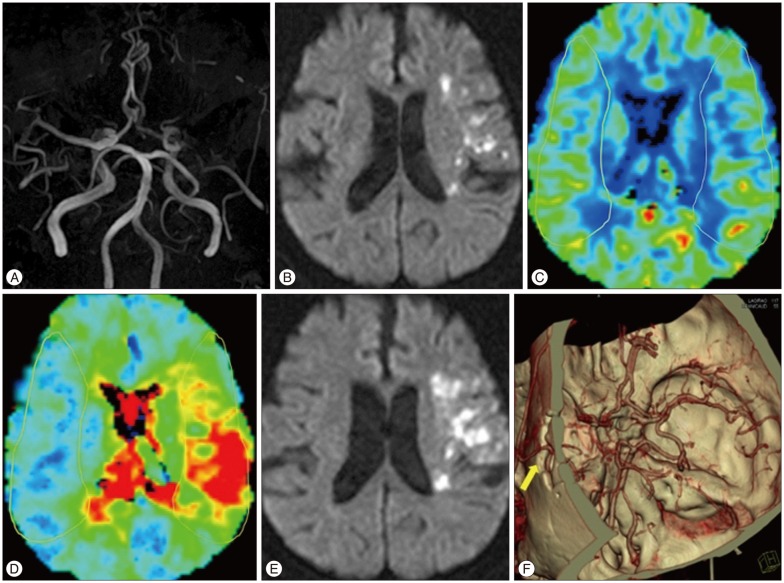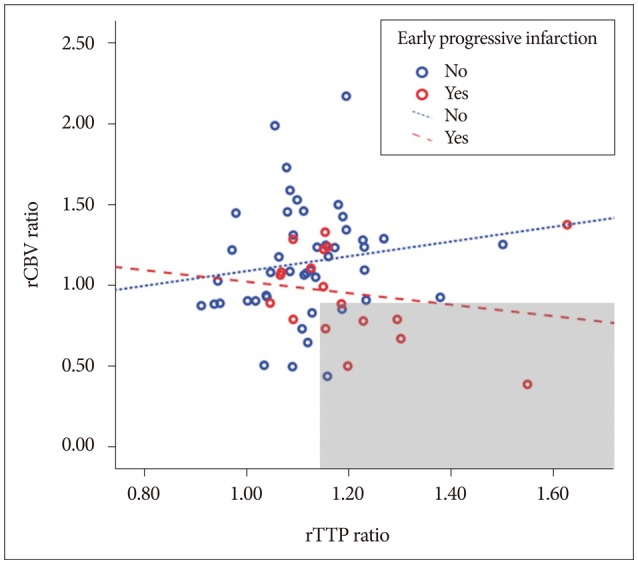1. Alawneh JA, Moustafa RR, Baron JC. Hemodynamic factors and perfusion abnormalities in early neurological deterioration. Stroke. 2009; 40:e443–e450. PMID:
19390076.

2. Birschel P, Ellul J, Barer D. Progressing stroke : towards an internationally agreed definition. Cerebrovasc Dis. 2004; 17:242–252. PMID:
14718754.

3. Campbell BC, Christensen S, Levi CR, Desmond PM, Donnan GA, Davis SM, et al. Cerebral blood flow is the optimal CT perfusion parameter for assessing infarct core. Stroke. 2011; 42:3435–3440. PMID:
21980202.

4. Campbell BC, Christensen S, Tress BM, Churilov L, Desmond PM, Parsons MW, et al. Failure of collateral blood flow is associated with infarct growth in ischemic stroke. J Cereb Blood Flow Metab. 2013; 33:1168–1172. PMID:
23652626.

5. Dávalos A, Cendra E, Teruel J, Martinez M, Genís D. Deteriorating ischemic stroke : risk factors and prognosis. Neurology. 1990; 40:1865–1869. PMID:
2247235.
6. Desilles JP, Meseguer E, Labreuche J, Lapergue B, Sirimarco G, Gonzalez-Valcarcel J, et al. Diabetes mellitus, admission glucose, and outcomes after stroke thrombolysis : a registry and systematic review. Stroke. 2013; 44:1915–1923. PMID:
23704108.

7. Eusebi P. Diagnostic accuracy measures. Cerebrovasc Dis. 2013; 36:267–272. PMID:
24135733.

8. Hjalmarsson C, Manhem K, Bokemark L, Andersson B. The role of prestroke glycemic control on severity and outcome of acute ischemic stroke. Stroke Res Treat. 2014; 2014:694569. PMID:
25295219.

9. Horiuchi T, Nitta J, Ishizaka S, Kanaya K, Yanagawa T, Hongo K. Emergency EC-IC bypass for symptomatic atherosclerotic ischemic stroke. Neurosurg Rev. 2013; 36:559–564. discussion 564-565. PMID:
23821132.

10. Hou Q, Zuo Z, Michel P, Zhang Y, Eskandari A, Man F, et al. Influence of chronic hyperglycemia on cerebral microvascular remodeling : an in vivo study using perfusion computed tomography in acute ischemic stroke patients. Stroke. 2013; 44:3557–3560. PMID:
24029632.

11. Jia Q, Zhao X, Wang C, Wang Y, Yan Y, Li H, et al. Diabetes and poor outcomes within 6 months after acute ischemic stroke : the China National Stroke Registry. Stroke. 2011; 42:2758–2762. PMID:
21852614.

12. Jørgensen HS, Nakayama H, Raaschou HO, Olsen TS. Effect of blood pressure and diabetes on stroke in progression. Lancet. 1994; 344:156–159. PMID:
7912765.

13. Kawai N, Keep RF, Betz AL. Hyperglycemia and the vascular effects of cerebral ischemia. Acta Neurochir Suppl. 1997; 70:27–29. PMID:
9416268.

14. Khatri R, Rodriguez GJ, Suri MF, Vazquez G, Ezzeddine MA. Lepto meningeal collateral response and computed tomographic perfusion mismatch in acute middle cerebral artery occlusion. J Vasc Interv Neurol. 2011; 4:1–4. PMID:
22518259.
15. Kimura K, Sakamoto Y, Iguchi Y, Shibazaki K, Aoki J, Sakai K, et al. Admission hyperglycemia and serial infarct volume after t-PA therapy in patients with and without early recanalization. J Neurol Sci. 2011; 307:55–59. PMID:
21624623.

16. Kluytmans M, van Everdingen KJ, Kappelle LJ, Ramos LM, Viergever MA, van der. Prognostic value of perfusion- and diffusion-weighted MR imaging in first 3 days of stroke. Eur Radiol. 2000; 10:1434–1441. PMID:
10997432.

17. Kwan J, Hand P. Early neurological deterioration in acute stroke : clinical characteristics and impact on outcome. QJM. 006; 99:625–633. PMID:
16905751.

18. Lee SB, Huh PW, Kim DS, Yoo DS, Lee TG, Cho KS. Early superficial temporal artery to middle cerebral artery bypass in acute ischemic stroke. Clin Neurol Neurosurg. 2013; 115:1238–1244. PMID:
23266265.

19. Lee SY, Cha JK, Kang MJ. Regional cerebral blood volume ratio on perfusion MRI on the growth of infarct size in acute ischemic stroke. Eur Neurol. 2009; 62:281–286. PMID:
19690421.

20. Lemkes BA, Hermanides J, Devries JH, Holleman F, Meijers JC, Hoekstra JB. Hyperglycemia : a prothrombotic factor? J Thromb Haemost. 2010; 8:1663–1669. PMID:
20492456.
21. Liu Y, Karonen JO, Vanninen RL, Nuutinen J, Koskela A, Soimakallio S, et al. Acute ischemic stroke : predictive value of 2D phase-contrast MR angiography--serial study with combined diffusion and perfusion MR imaging. Radiology. 2004; 231:517–527. PMID:
15044743.

22. Neumann-Haefelin T, Wittsack HJ, Fink GR, Wenserski F, Li TQ, Seitz RJ, et al. Diffusion- and perfusion-weighted MRI : influence of severe carotid artery stenosis on the DWI/PWI mismatch in acute stroke. Stroke. 2000; 31:1311–1317. PMID:
10835450.
23. Nussbaum ES, Janjua TM, Defillo A, Lowary JL, Nussbaum LA. Emergency extracranial-intracranial bypass surgery for acute ischemic stroke. J Neurosurg. 2010; 112:666–673. PMID:
19499983.

24. Reeves MJ, Vaidya RS, Fonarow GC, Liang L, Smith EE, Matulonis R, et al. Quality of care and outcomes in patients with diabetes hospitalized with ischemic stroke : findings from Get With the Guidelines-Stroke. Stroke. 2010; 41:e409–e417. PMID:
20224058.
25. Schaefer PW, Hunter GJ, He J, Hamberg LM, Sorensen AG, Schwamm LH, et al. Predicting cerebral ischemic infarct volume with diffusion and perfusion MR imaging. AJNR Am J Neuroradiol. 2002; 23:1785–1794. PMID:
12427640.
26. Schaefer PW, Souza L, Kamalian S, Hirsch JA, Yoo AJ, Kamalian S, et al. Limited reliability of computed tomographic perfusion acute infarct volume measurements compared with diffusion-weighted imaging in anterior circulation stroke. Stroke. 2015; 46:419–424. PMID:
25550366.

27. Seners P, Turc G, Oppenheim C, Baron JC. Incidence, causes and predictors of neurological deterioration occurring within 24 h following acute ischaemic stroke : a systematic review with pathophysiological implications. J Neurol Neurosurg Psychiatry. 2015; 86:87–94. PMID:
24970907.

28. Shimoyama T, Shibazaki K, Kimura K, Uemura J, Shiromoto T, Watanabe M, et al. Admission hyperglycemia causes infarct volume expansion in patients with ICA or MCA occlusion : association of collateral grade on conventional angiography. Eur J Neurol. 2013; 20:109–116. PMID:
22747888.

29. Srinivasan A, Goyal M, Al Azri F, Lum C. State-of-the-art imaging of acute stroke. Radiographics. 2006; 26(Suppl 1):S75–S95. PMID:
17050521.

30. Toni D, Fiorelli M, Gentile M, Bastianello S, Sacchetti ML, Argentino C, et al. Progressing neurological deficit secondary to acute ischemic stroke. A study on predictability, pathogenesis, and prognosis. Arch Neurol. 1995; 52:670–675. PMID:
7619022.

31. Toyoda K, Fujimoto S, Kamouchi M, Iida M, Okada Y. Acute blood pressure levels and neurological deterioration in different subtypes of ischemic stroke. Stroke. 2009; 40:2585–2588. PMID:
19407233.

32. Vaidyula VR, Rao AK, Mozzoli M, Homko C, Cheung P, Boden G. Effects of hyperglycemia and hyperinsulinemia on circulating tissue factor procoagulant activity and platelet CD40 ligand. Diabetes. 2006; 55:202–208. PMID:
16380494.

33. Wahlgren N, Ahmed N, Dávalos A, Ford GA, Grond M, Hacke W, et al. Thrombolysis with alteplase for acute ischaemic stroke in the Safe Implementation of Thrombolysis in Stroke-Monitoring Study (SITS-MOST) : an observational study. Lancet. 2007; 369:275–282. PMID:
17258667.

34. Yamada K, Wu O, Gonzalez RG, Bakker D, Østergaard L, Copen WA, et al. Magnetic resonance perfusion-weighted imaging of acute cerebral infarction : effect of the calculation methods and underlying vasculopathy. Stroke. 2002; 33:87–94. PMID:
11779894.









 PDF
PDF ePub
ePub Citation
Citation Print
Print



 XML Download
XML Download